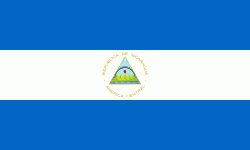El Sauce (El Sauce)
El Sauce is a town and a municipality in the León Department of Nicaragua. Located in the foothills of the Segovia Mountains, the municipality has a population of 31,664 and covers an area of 693 km2.
El Sauce is bordered to the north by the municipalities of San José de Achuapa and Estelí and bordered to the south by the municipality of Larreynaga.
El Sauce was originally called Guayabal. The town gained much attention when a statue called the Black Christ of Esquipulas was sent there from Guatemala was placed for the first time under a willow tree. From then, the area was renamed "El Sauce".
During the decade of 1900, El Sauce was a railway crossing which included items such as coffee and animals being moved to the port city of Corinto. The railway closed 40 years ago because it was sold as scrap, an event that had significant impact on the railway closure. El Sauce is still a small town dedicated to agricultural production, bees, and livestock.
The town was the site of a battle that pitted the American Marines and Nicaraguan National Guardsmen against Sandinista rebels on December 26, 1932, during the Sandino Rebellion. It was the last major action of the war.
El Sauce is bordered to the north by the municipalities of San José de Achuapa and Estelí and bordered to the south by the municipality of Larreynaga.
El Sauce was originally called Guayabal. The town gained much attention when a statue called the Black Christ of Esquipulas was sent there from Guatemala was placed for the first time under a willow tree. From then, the area was renamed "El Sauce".
During the decade of 1900, El Sauce was a railway crossing which included items such as coffee and animals being moved to the port city of Corinto. The railway closed 40 years ago because it was sold as scrap, an event that had significant impact on the railway closure. El Sauce is still a small town dedicated to agricultural production, bees, and livestock.
The town was the site of a battle that pitted the American Marines and Nicaraguan National Guardsmen against Sandinista rebels on December 26, 1932, during the Sandino Rebellion. It was the last major action of the war.
Map - El Sauce (El Sauce)
Map
Country - Nicaragua
 |
 |
| Flag of Nicaragua | |
Originally inhabited by various indigenous cultures since ancient times, the region was conquered by the Spanish Empire in the 16th century. Nicaragua gained independence from Spain in 1821. The Mosquito Coast followed a different historical path, being colonized by the English in the 17th century and later coming under British rule. It became an autonomous territory of Nicaragua in 1860 and its northernmost part was transferred to Honduras in 1960. Since its independence, Nicaragua has undergone periods of political unrest, dictatorship, occupation and fiscal crisis, including the Nicaraguan Revolution of the 1960s and 1970s and the Contra War of the 1980s.
Currency / Language
| ISO | Currency | Symbol | Significant figures |
|---|---|---|---|
| NIO | Nicaraguan córdoba | C$ | 2 |
| ISO | Language |
|---|---|
| EN | English language |
| ES | Spanish language |















